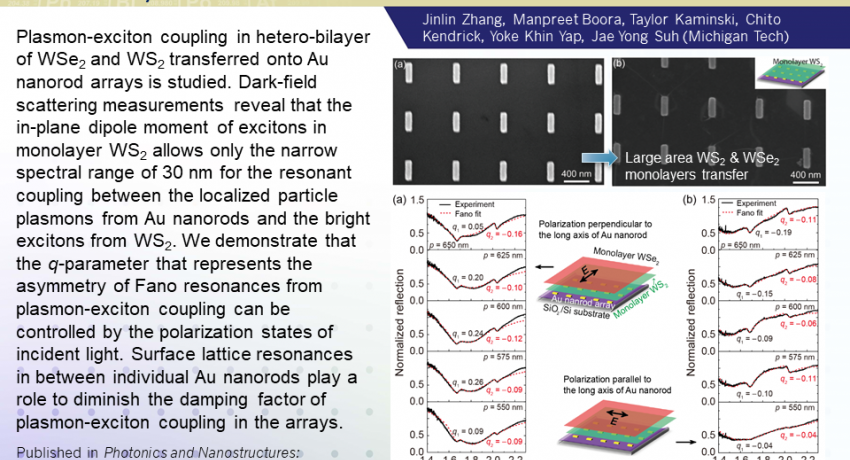What Has Been Achieved:
(1) Plasmon-exciton coupling in metallic grating structure. We demonstrate that the plasmon-exciton coupling occurs in relation to the direction of dipole moments in two-dimensional monolayers whereas the optical scattering spectra follow the grating equation. (2) Control of Fano parameter. Two Fano resonances exist simultaneously in bilayer WSe2-WS2 interacting with gold nanorods. The q-parameters that represent the asymmetry of Fano lineshape can be controlled by the polarization state of incident light with respect to the orientation of gold nanorods.
Importance of Achievement:
Plasmon-exciton coupling has received great attention because of the key advantages of plasmonic nanostructures exploiting the light-matter interactions at subwavelength scale. Fano resonances, on the other hand, are ubiquitous phenomenon in photonics occurring when a discrete localized state couples to a continuum of state. Thus, observing and controlling Fano resonances in nanostructures that support plasmon-exciton coupling is important for designing robust optical materials with many applications in photonics and spectroscopy.
Unique Features of the MIP That Enabled Project:
MOCVD growth of large area WS2 and WSe2 monolayers.
Publication:
Jinlin Zhang, Manpreet Boora, Taylor Kaminski, Chito Kendrick, Yoke Khin Yap, Jae Yong Suh, Fano resonances from plasmon-exciton coupling in hetero-bilayer WSe2-WS2 on Au nanorod arrays, Photonics and Nanostructures: Fundamentals and Applications, 38, 100783 (2020).
Credits/Names: Jinlin Zhang, Manpreet Boora, Taylor Kaminski, Chito Kendrick, Yoke Khin Yap, Jae Yong Suh (Michigan Tech)
Download PDF Version: MIP-2DCC-1539916_Fano resonances from plasmon-exciton coupling in hetero-bilayer WSe2-WS2.pdf
Year of Research Highlight: 2020
Select a Highlight Type: User Highlight
